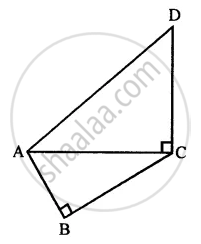Advertisements
Advertisements
Questions
In ∆ ABC, AD ⊥ BC.
Prove that AC2 = AB2 +BC2 − 2BC x BD
In ∆ ABC (Figure 3), AD ⊥ BC.
Prove that AC2 = AB2 +BC2 − 2BC x BD

Solution
Applying Pythagoras theorem in ΔADB, we obtain
AD2 + DB2 = AB2
⇒ AD2 = AB2 − DB2 .....(1)
Applying Pythagoras theorem in ΔADC, we obtain
AD2 + DC2 = AC2
AB2 − BD2 + DC2 = AC2 ...[Using equation (1)]
AB2 − BD2 + (BC − BD)2 = AC2
AC2 = AB2 − BD2 + BC2 + BD2 −2BC x BD
AC2 = AB2 + BC2 − 2BC x BD
RELATED QUESTIONS
For finding AB and BC with the help of information given in the figure, complete following activity.
AB = BC .......... 
∴ ∠BAC = 
∴ AB = BC =  × AC
× AC
=  × `sqrt8`
× `sqrt8`
=  × `2sqrt2`
× `2sqrt2`
= 

Two poles of heights 6 m and 11 m stand vertically on a plane ground. If the distance between their feet is 12 m;
find the distance between their tips.
Prove that in a right angle triangle, the square of the hypotenuse is equal to the sum of squares of the other two sides.
In the given figure, AD = 13 cm, BC = 12 cm, AB = 3 cm and angle ACD = angle ABC = 90°. Find the length of DC.

Find the Pythagorean triplet from among the following set of numbers.
3, 4, 5
Find the length of the hypotenuse of a triangle whose other two sides are 24cm and 7cm.
For going to a city B from city A, there is a route via city C such that AC ⊥ CB, AC = 2x km and CB = 2(x + 7) km. It is proposed to construct a 26 km highway which directly connects the two cities A and B. Find how much distance will be saved in reaching city B from city A after the construction of the highway.
Prove that the area of the semicircle drawn on the hypotenuse of a right angled triangle is equal to the sum of the areas of the semicircles drawn on the other two sides of the triangle.
In an isosceles triangle PQR, the length of equal sides PQ and PR is 13 cm and base QR is 10 cm. Find the length of perpendicular bisector drawn from vertex P to side QR.
Two angles are said to be ______, if they have equal measures.
